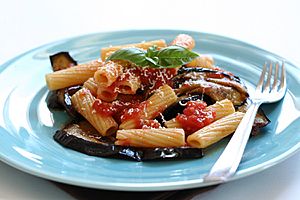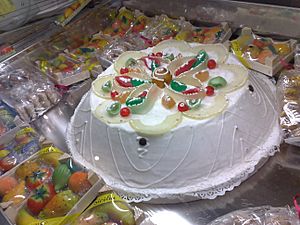Sicilian cuisine facts for kids
Sicilian cuisine is the unique way of cooking food on the island of Sicily. It's like a delicious history book! You can taste the influences of many different cultures that have lived on the island for over 2,000 years. While it shares a lot with Italian cuisine, Sicilian food also has flavors from Greece, Spain, France, Jewish traditions, and Arab cooking.
A Sicilian cook named Mithaecus lived around 500 BC. He is known for sharing Sicilian cooking knowledge with Greece. His cookbook was the first ever written in Greek. This makes him the earliest cookbook author we know by name.
Contents
History of Sicilian Food
Many Greek colonists first settled a large part of Sicily. They introduced a love for fish, wheat, olives, grapes, broad beans, chickpeas, lentils, almonds, pistachios, and fresh vegetables.
Arab influences came to Sicilian cooking when Arabs ruled Sicily in the 900s and early 1000s. They brought sugar, citrus fruits, rice, raisins, pine nuts, and spices like saffron, nutmeg, and cinnamon. The Normans also left their mark, especially with their love for meat dishes.
The Jewish community living on the island also added to Sicilian food. They were the ones who started frying garlic in olive oil for sauces. Later, the Spanish brought many new foods from the Americas. These included cocoa, maize (corn), peppers, zucchini, potatoes, and tomatoes.
Today, much of the island's cooking uses fresh vegetables like eggplant, artichoke, and tomatoes. Popular fish include tuna, sea bream, sea bass, cuttlefish, and swordfish. In Trapani, on the far west side of Sicily, you can clearly see North African influences, especially in the use of couscous.
Popular Sicilian Dishes
Tasty Starters
Starters, called antipasti, are a key part of Sicilian meals. Some common Sicilian starters include caponata and gatò di patate. Caponata is a sweet and sour vegetable dish. Gatò di patate is a type of potato and cheese pie.
Hearty Soups
Maccu is a traditional Sicilian soup made mainly with fava beans. It was a simple, everyday food for farmers long ago. Maccu di San Giuseppe (meaning maccu of St. Joseph) is a special Sicilian dish. It has many ingredients and is often made on Saint Joseph's Day in Sicily. This helps clear out food from the pantry to make space for new spring vegetables.
Delicious Pasta Dishes
Sicily is the oldest place in Italy and the Western world where long, thin pasta was part of local cooking. This goes back to the 1100s. An old book called the Tabula Rogeriana mentions these traditions from the Sicilian kingdom.
Some of the most popular Sicilian pasta dishes are:
- Spaghetti ai ricci di mare (spaghetti with sea urchin).
- Pasta con le sarde (with sardines).
- Pasta alla Norma (a special dish from Catania).
Cannelloni is another common pasta dish. In eastern Sicily, pasta with capuliato (a type of chopped dried tomato) is also very popular.
Main Courses
After the pasta, a typical Sicilian meal includes a second or main dish (secondi). These are usually based on meat or fish. Main dishes made with seafood include couscous al pesce (couscous with fish) and pesce spada alla ghiotta (swordfish cooked in a rich sauce).
Sweet Desserts and Treats
Sweets are a very special part of Sicilian food. Some examples are:
- Frutta martorana (marzipan fruits).
- Pignolata of Messina (fried dough balls with glaze).
- Buccellato (a ring-shaped fig cake).
- Cannoli (crispy pastry shells filled with creamy ricotta cheese).
- Granita (a semi-frozen dessert).
- Cassata siciliana (a colorful sponge cake with ricotta).
- The Crocetta of Caltanissetta, a sweet that was lost and then found again in 2014.
Candy making in Sicily was greatly influenced by Arab candy makers in the 800s. Sicilian candy has kept more of this influence than almost any other place in Europe. Marzipan fruits might have been created at the Convent of Eloise at Martorana in the 1300s. In the 1600s and 1700s, many Sicilian monasteries made candies and pastries.
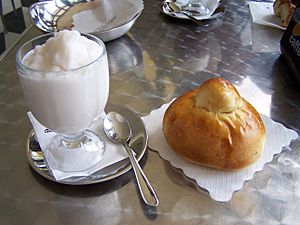
Granita is especially famous. It is a semi-frozen dessert made from sugar, water, and flavorings. It comes from Sicily and is often linked to Messina or Catania. Granita is similar to sorbet and Italian ice. In most of Sicily, it has a rougher, more icy texture. The texture can change from city to city on the island. In western Sicily, it is chunkier. In the east, it is almost as smooth as sorbet. This is because of different freezing methods. Smoother types are made in a gelato machine. Coarser types are frozen with less mixing and then scraped into crystals.
Fresh Fruits
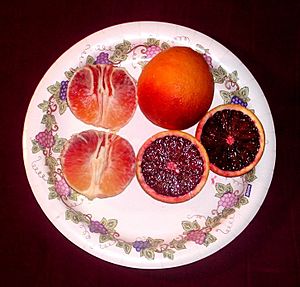
Citrus fruits are a popular ingredient in Sicilian cooking. Many were first brought by the Arabs between the 800s and 1000s. However, some, like the Washington navel orange from Brazil, arrived more recently.
Here are some citrus fruits found in Sicily:
- Biondo comune: A "common blonde" orange.
- Ovale: An orange that ripens in April and May, with firm flesh.
- Sanguigno comune: A common blood orange harvested from January to April.
- Washington navel: Introduced from Brazil in the 1940s-1950s. It grows mainly near Ribera and Sciacca and is picked from November to January.
- Sanguinella: A bitter blood orange found in Paternò Santa Maria di Licodia, Palagonia, Scordia, and Francofonte from January to April.
- Tarocco: A high-quality blood orange found in Catania, Siracusa, and Francofonte from November to January.
- Tarocco dal muso: A bell-shaped orange found in Francofonte.
- Valencia: Similar to the Ovale and often used in sweets.
- Moro: An orange with crimson-colored flesh found in Lentini, Scordia, and Francofonte from mid-January to late April.
- Comune: A common type of mandarin orange.
- Mandarino tardivo di Ciaculli : A second type of mandarin orange found in Sicily.
- Femminello, Siracusa lemon: This lemon makes up 80% of Sicily's lemon crop. It is found in Catania, Syracuse, Messina, and Palermo.
- Monachello: A "little monk" lemon harvested from October to March. It can handle dry weather better than the Femminello.
- Verdello: A lime that grows very well and is harvested from May to September.
Wines and Other Drinks
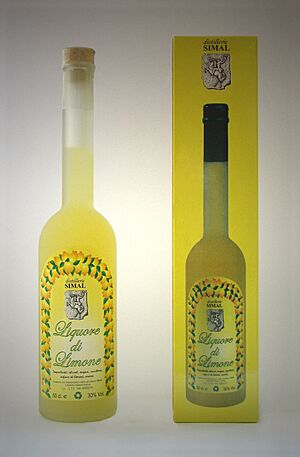
The drink most often served with a main meal in Sicily is wine. The soil and climate in Sicily are perfect for growing grapes. This is especially true around Mount Etna. People have been making wine on the island since the Greeks first settled there. Today, all areas of Sicily produce wine. Sicilian wine made with modern methods is popular in Europe.
Sicilian red wines are often enjoyed in the evening with roasted or grilled meat. Famous red wines include the Cerasuolo di Vittoria and the Nero d'Avola. These are mainly made around Noto (Siracusa). Dry white wines and rosés are usually drunk with fish, chicken, and pasta dishes. Sicily is also known for making dessert wines, like Marsala and the Malvasia delle Lipari.
Other common Sicilian drinks include limoncello, which is a lemon liqueur. There is also Amaro Siciliano, a herbal drink. This is often had after meals to help with digestion.
Popular Street Food
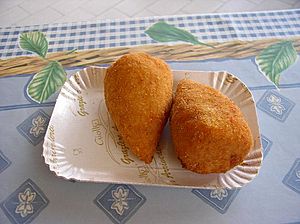
Sicilians love to eat street food! This includes the famous arancini, which are deep-fried rice balls. They are usually filled with meat sauce, cheese, or peas, and then covered in bread crumbs.
Other popular street foods are:
- Pani ca meusa (bread with spleen) and pane e panelle (bread with chickpea fritters) in the Palermo area.
- Cartocciate (fried dough with filling) and cipolline (small savory pastries) in the Catania area.
- Focaccia messinese (Messina focaccia) and Pidone messinese (a type of savory pastry) in the Messina area.
See also
 In Spanish: Gastronomía de Sicilia para niños
In Spanish: Gastronomía de Sicilia para niños
- Biscotti Regina
- Italian cuisine
- List of Sicilian dishes
- Sicilian pizza


